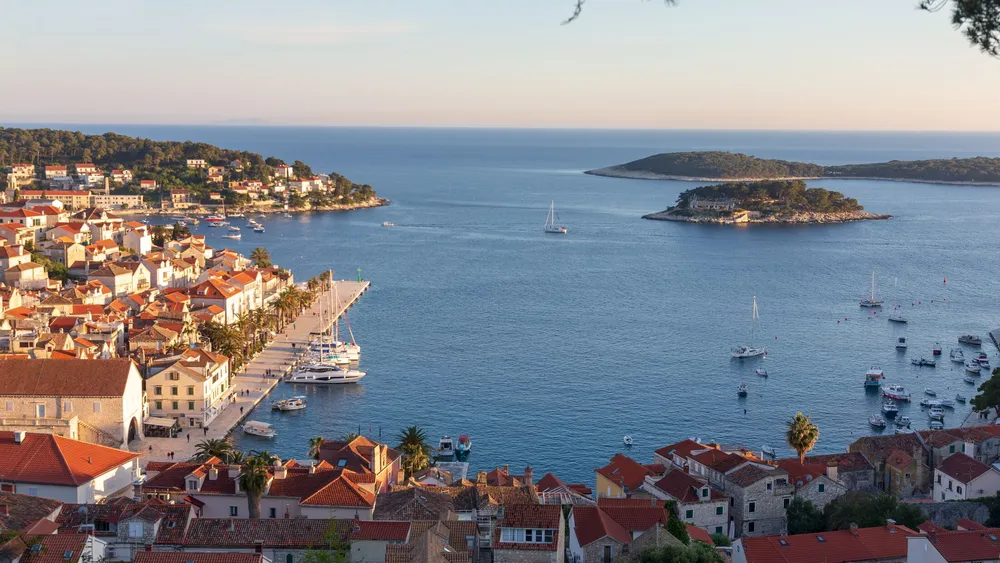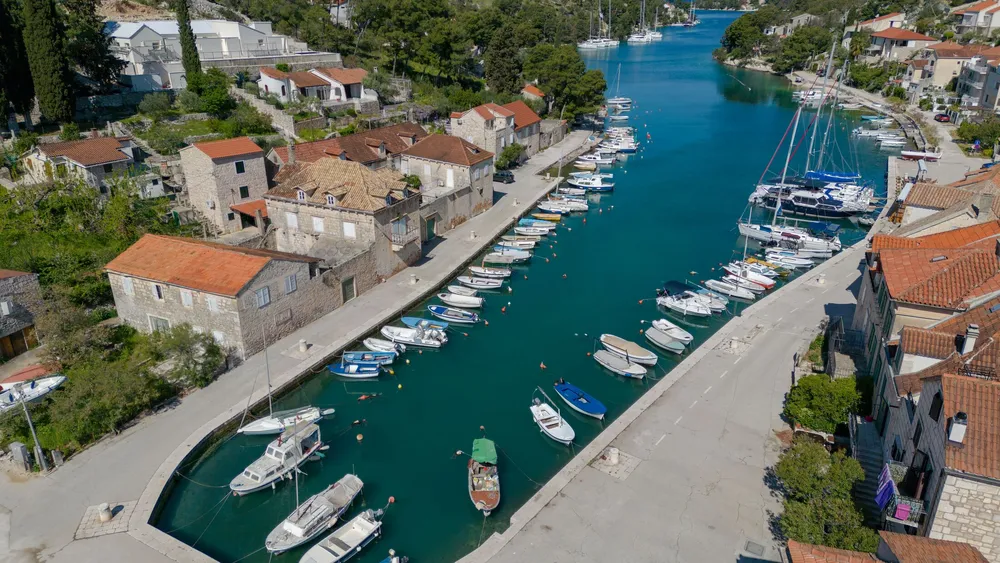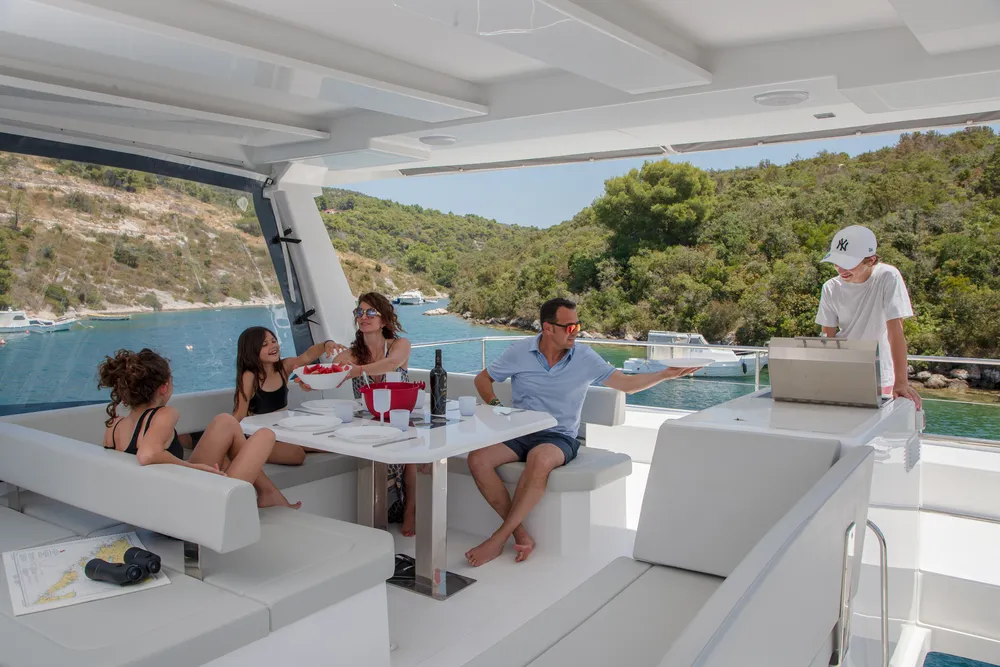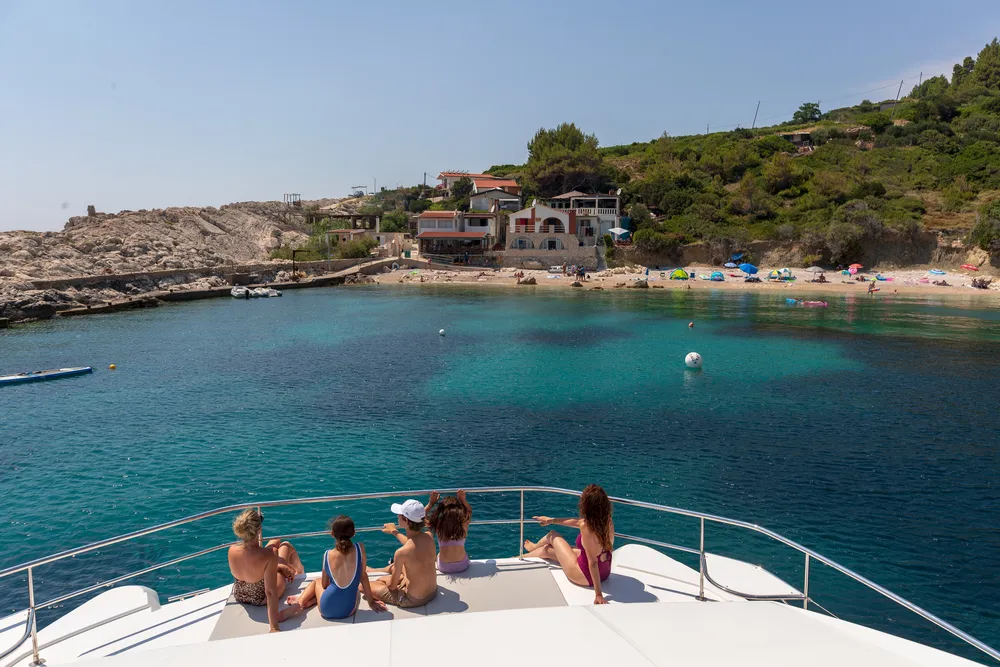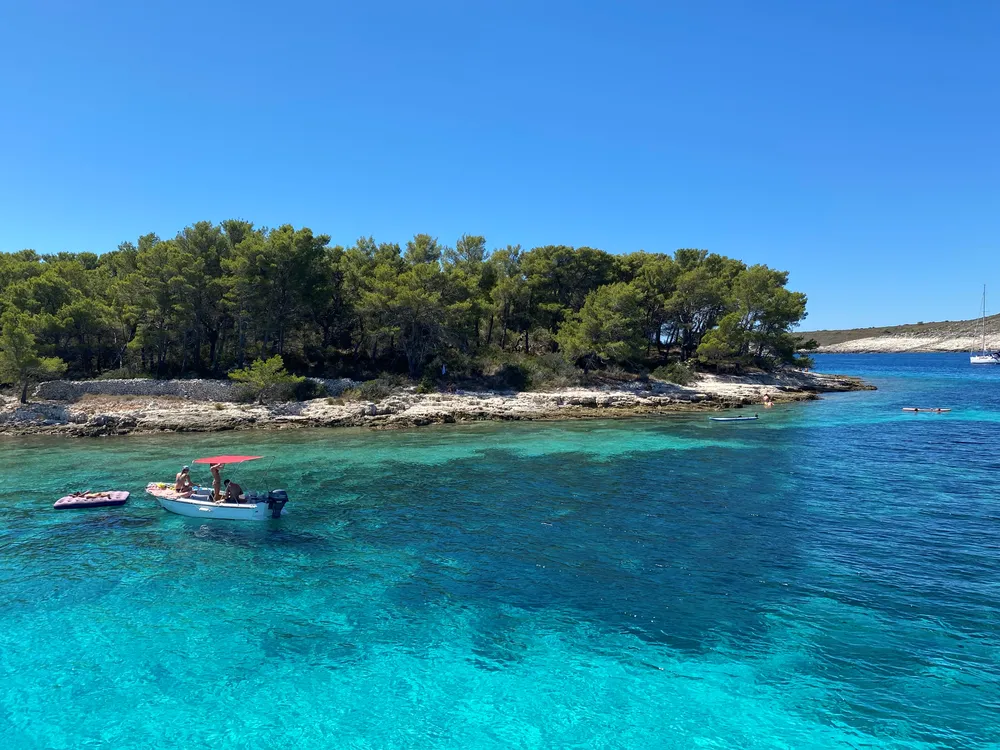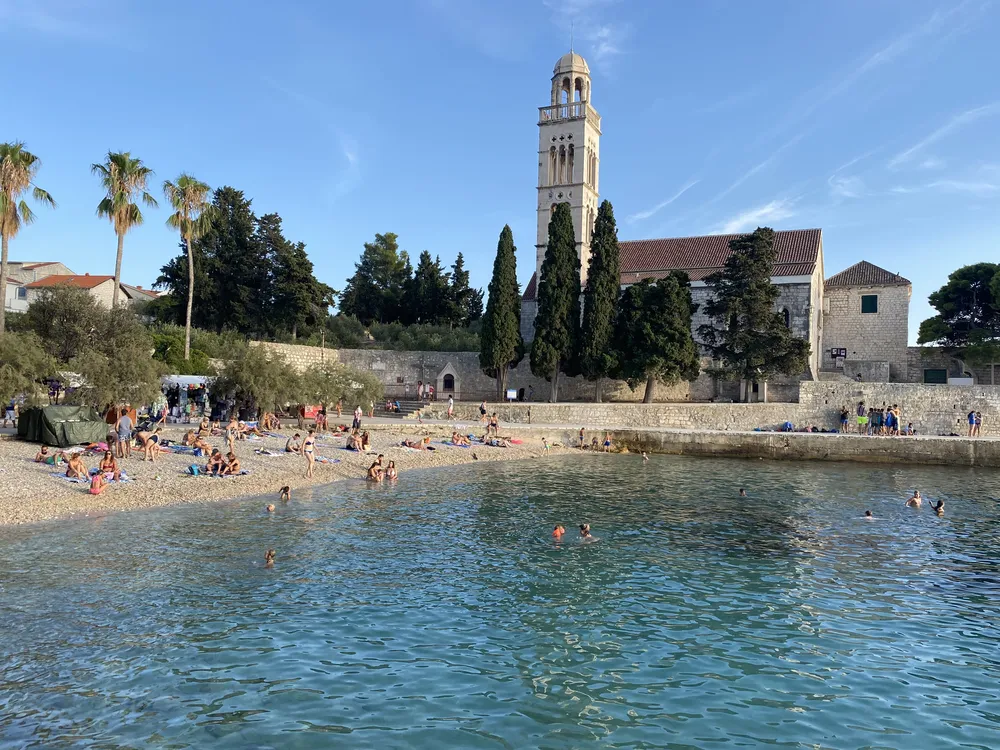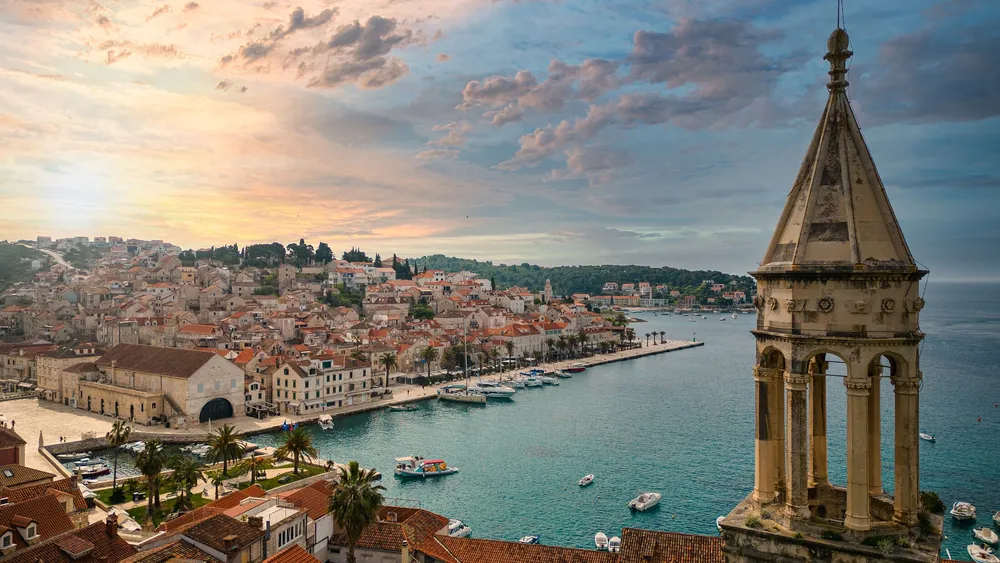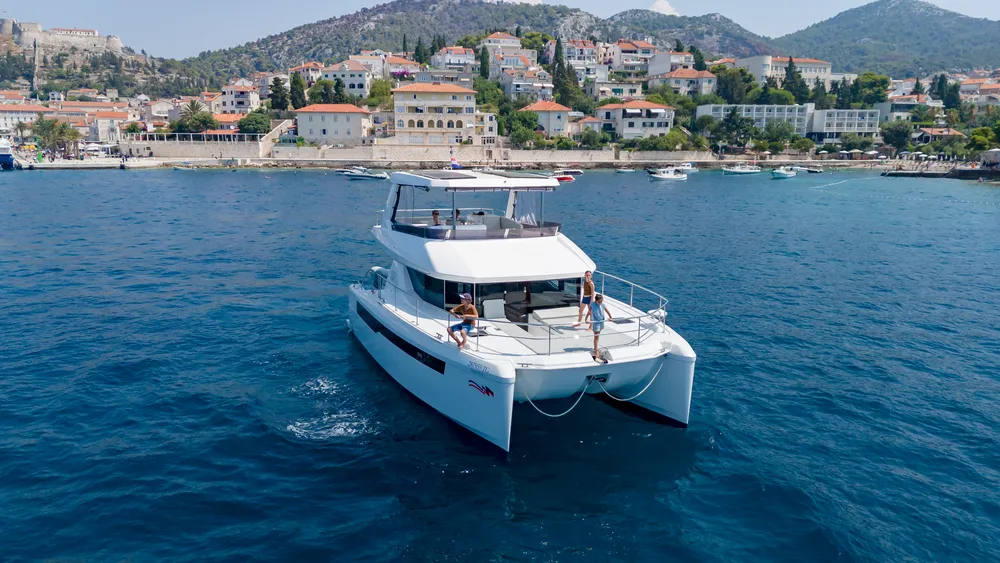In Marina Agana, Dalmatia lies at your feet. Countless anchorages, one more beautiful than the next, can be reached by motorboat in less than an hour. Croatia has become a tourist stronghold in recent years. The country has made a name for itself as a boating paradise. We take you on a trip with a Moorings 402P along the breathtaking coast and to the offshore islands.
The trip starts in Agana, more precisely at the base of Sunsail/The Moorings, 30 kilometers northwest of Split, and offers plenty of unforgettable experiences: hidden bays, picturesque fishing harbours and small islands in the turquoise blue sea. If you can’t wait to set off, order your provisions online from Moorings. It will be delivered directly to your boat. This will save you valuable time and you won’t have to push a shopping cart around in the blazing sun. You’ll be ready to go after the skipper’s briefing and can start the engines immediately afterwards. For the first evening, reserve a table in a restaurant on the island of Šolta, including a mooring buoy. It is only 10 nautical miles away.
Afternoon thermals and quiet nights
On the way out of Agana Bay, the sea is choppy due to the north-westerly thermals that often occur in the afternoon. The waves practically come from behind. With gentle rocking movements, you can slowly get used to your home for the next few days. You’ll soon acquire a taste for it and choose the flybridge as your favorite spot.next stop are the round islands off the northwestern tip of Šolta. After a short detour off Maslinica, you will reach the rocky bay of Šešula. A restaurant employee assigns guests a boat mooring. Take your time and use the dinghy as a bow or stern thruster if necessary. On the Croatian islands, many restaurants offer their guests a free mooring. In view of the mooring prices, this is an excellent deal!
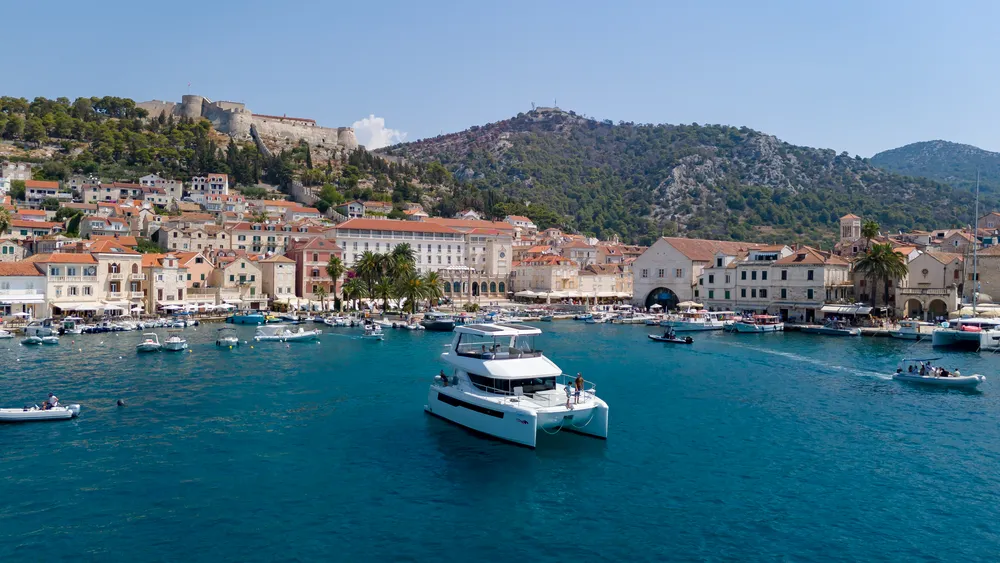
Islands everywhere with hundreds of anchorages
After mostly calm nights, you can bob around off Šolta for a while before moving on to Split. As the compact Powerkat is very easy to maneuver, it is ideal for island hopping. Take the opportunity to go swimming at the most beautiful spots. If crew members want to board or disembark, the small seaside resort of Okrug on the west coast of the island of Ciovo is a good choice. The international airport is only 9 kilometers away and there are plenty of cabs available. The anchorage is very quiet, but a well-protected bay one nautical mile further west is even more recommended for overnight stays.
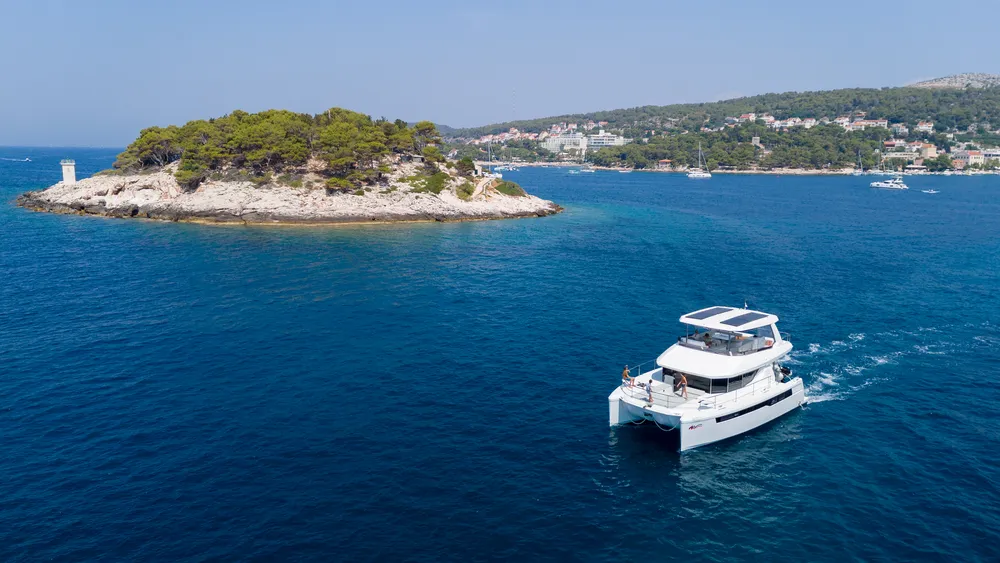
Hvar, the St. Tropez of Croatia
If there is one island you should definitely not miss out on, it is Hvar. The island and its world-famous harbor bear the same name. But before you pay a visit to Croatia’s St. Tropez, take a stroll through Brač and visit the west of the island of Hvar. Arriving in the old Venetian harbor can be sobering.
There is often a traffic jam. There is a queue of boats, moorings are expensive and the area is choppy due to the heavy traffic. If all this is too much for you, break off the exercise and head for the small island of Otok Jerolim, just half a nautical mile away. The anchorage there faces north, but the north-westerly wind usually dies down quickly. The dinghy will take you to the harbour in no time, where you can stroll through the old town and do some shopping before ending the day in a restaurant with seafood or other local specialties.
Korčula, the medieval
After Hvar, the somewhat more inconspicuous but no less charming island of Korčula awaits. It is praised in cruising guides as the greenest of the Croatian islands. Sail between the two islands, with a view of the mainland, where the clouds often cling to the high mountains, and enjoy the idyllic, often deserted area. There are many moorings near the city walls of Korčula where you can avoid the hefty harbor fees – 100 to 400 euros! – can be avoided. We recommend spending the evening in the medieval town and its imposing fortifications. The eastern tip of Korčula offers fantastic, wind-protected anchorages. Less suitable is the much more inhospitable, windswept south. The journey against the wind and waves can be a bit sporty here, but the two 320 hp diesel engines do their job well! Moor at a buoy in Gradina to relax and visit the fishing port of Vela Luka.
Trogis and its marble harbor promenade
If you still have a little time left, make a detour to Vis. The island was a military base for a long time and was only recently developed for tourism. As it is the furthest away from the mainland, it is still quiet here. It also offers a very special sight: the Blue Grotto, which you should definitely not miss.
Then it’s back to Hvar, or more precisely to the Pakleni Islands. They are teeming with anchoring opportunities. One of the best protected and most beautiful is located north of Marinkovak. Many restaurants offer buoy moorings. The water is turquoise, but unfortunately the place is a bit crowded. On the last day, it is best to set off early towards the mainland. There is usually still no wind and the sea is as smooth as glass. If you find a place, moor for an hour or two in the harbor of Trogir with its marble promenade and visit the medieval town. A final lunch on board followed by a swim in the sea, a refueling stop and you are back at the base after 200 adventurous and fascinating nautical miles
The most beautiful islands
Hvar
At 68 kilometers, Hvar is the longest of the Croatian islands. It is best known for the town of the same name. With its Venetian, Gothic and Renaissance buildings, it not only delights lovers of architecture and history. The entrance to the harbor alone is impressive. There you can either moor at the pier or at one of the anchor buoys. It’s best to try your luck in the early afternoon. Hvar is considered the local St. Tropez. In summer, people party all night long. Directly opposite are the 21 Pakleni or Hell’s Islands with countless anchorages in turquoise to deep blue water. However, the most beautiful bays can be found on the wild north coast of Hvar.
Brac
To the north of Hvar lies Brac, the stronghold of Dalmatian olive oil. It is more mountainous than the other islands, with its highest point reaching 778 meters. Most of the anchorages are in the west and northeast, but the most famous is in the south: the pebble beach Zlatni Rat. It is also known as the Golden Horn of Bol because of its unique shape. Its turquoise-blue water attracts many sailors and kite surfers. It is much less busy here in the low season.
Korčula
Our favorite island! One reason for this is the beautiful fortress town of the same name, which is definitely not to be missed. You can either dock in one of the two harbors or moor at the nearby anchorage. Secondly, Korčula is the greenest island in the region. Pines, olive trees, maquis and even vines on the south side form a stark contrast to the barren land and rocky landscape. Last but not least, Korčula has stunning anchorages such as Kneza in the north, near the Badija monastery or on the island of Vrnik in the east.
Vis
Vis is one of the furthest islands from the mainland. Despite this distance (30 nautical miles), it is very popular with boaters. In addition to the numerous bays of the rugged coastline, several island chains, especially in the northeast and east, offer many large anchorages. Vis is a well-known diving area, but the biggest underwater attraction is the Blue Cave of Biševo, which is currently closed to diving. Between 10 a.m. and 1 p.m., the sunlight falls into the cave and makes the water glow an intense blue. Right next to it is Salbunara Bay with one of the few sandy beaches in Dalmatia.
Šolta
Šolta in the immediate vicinity of Trogir is much quieter than its neighboring islands. In some places it is a little melancholy. Due to the decline in population – the number of inhabitants has shrunk from 3687 in 1900 to 1500 today – many houses inland are empty and gradually falling into disrepair. There are secluded anchorages on the south coast, as they cannot be reached from land. In the west, in U Sesula Bay, two restaurants offer their guests an anchor buoy for the night and a shuttle service.
Useful information
Dalmatia is located in the south of Croatia, but extends beyond the country’s borders to Montenegro and Herzegovina. The region can look back on a long and eventful history. Until the mid-1990s, it was still at war. Its status as a tourist magnet, which attracts crowds every year, is therefore still relatively recent. Despite the influx of visitors, the cities on the mainland such as Split, Trogir and Dubrovnik have lost none of their legendary architectural beauty, but the coasts are becoming increasingly ugly. We therefore prefer the countless and much more intact islands.
Population of Croatia: 4.058 million, including 852,000 in Dalmatia
Language: Croatian
Area of Croatia: 56 594 km2
Area of Dalmatia: 12 158 km2
Length of Croatian coastline: 5835 km
Largest airport: Split
Climate: Dalmatia has a Mediterranean climate with mild to cool, sometimes damp winters and dry, hot summers. From July to August, the average temperature is 25°C (min. 20°C, max. 30°C).
The two summer months are also the driest (80 mm of rainfall or 10% of the annual total). The water temperature fluctuates between 13°C in February and 25°C in August. From June to October it is above 20°C. Split has 2650 hours of sunshine per year. This means that it is sunny 60 percent of the time (an average of 7.2 hours per day). On the islands the sun shines a little more, on Hvar a total of 2800 hours.
Navigation conditions:
The two most feared winds in this part of the Adriatic are the bora, which descends from the mountains to the Adriatic coast as a stormy downdraft, especially in winter, and the hot scirocco, which blows from the south or southeast mainly in the fall. In summer, the synoptic winds are usually weak. In the afternoon, however, thermals from the west to northwest set in. When the wind is deflected and channeled by the longest and highest islands, it can reach over 30 knots in some very localized channels and rough seas with short waves can build up. The wind dies down again in the early evening and the sea calms down a little later, usually around midnight. As the anchorages are not only very numerous but also have different orientations, it is easy to find shelter. Even close to the coast, the sea is over 15 meters deep and the bottom is not particularly good. It is therefore advisable to moor in the Mediterranean way: anchor at the front and moor ashore at the back.
Bookings: moorings.com
Moorings 403PC – Small space miracle
The smallest Powerkat at the Moorings base in Agana Marina is the latest from the Leopard forge. It is practically new and has three cabins. The 40-footer replaces the Leopard 43PC and fits perfectly into the design of the new series, the main features of which are the elongated hull window and the huge flybridge. It inherits the impressive panoramic roof and the L-shaped galley from its predecessor. Despite its compact size, the cabins are incredibly spacious and are all equipped with island beds and heads compartments. A major advantage over the 43PC is the fully-fledged interior helm station, and Alexander Simonis has used his CFD (Computational Fluid Dynamics) software to optimize the longitudinal balance for a comfortable ride, which is much more difficult with short hulls than with long ones.
The yacht owner program briefly explained
With The Moorings’ yacht owner program, boat owners have the opportunity to charter boats at around twenty destinations with zero effort and cover a large part of the costs of their own boat with income from its rental. This is what it looks like in practice: Useful information You buy a standard boat, such as the Moorings 403PC, from the charter company. This is then used in the charter business for five to six years, during which you can choose from the 700 boats in the Moorings and Sunsail fleet for up to twelve weeks each year. There are no operating costs for you during this time. Mooring, insurance and maintenance costs are covered by The Moorings. At the end of the contract, you can keep your boat or sell it on.
